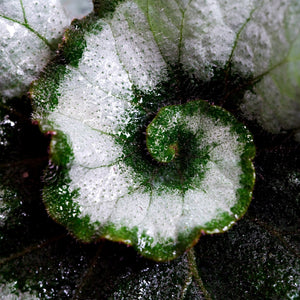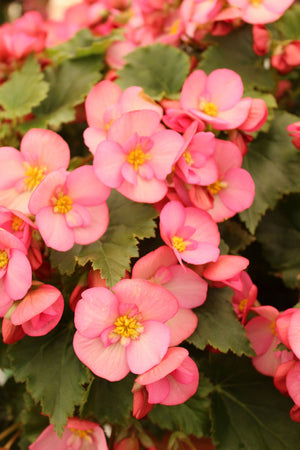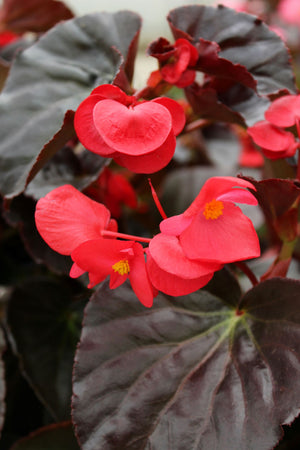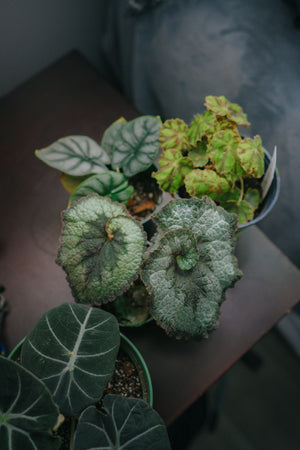The Begonia Guide
Begonias are a diverse and colorful group of plants known for their striking foliage and vibrant blooms. Whether grown indoors as houseplants or outdoors in shaded garden beds, begonias bring year-round beauty to any setting. With over 2,000 species and countless hybrids, there’s a begonia variety to suit every gardener’s preference. Here’s everything you need to know about growing and caring for begonias.

About
Begonias belong to the Begoniaceae family and are native to tropical and subtropical regions around the world. They are prized for their ornamental leaves, which often display intricate patterns, deep colors, and unique textures. Some varieties, like Begonia rex 'Jurassic Watermelon' and Begonia 'Escargot', are grown primarily for their foliage, while others, like Begonia x hiemalis and Begonia grandis subsp. evansiana 'Alba', produce stunning flowers.
Begonias can be categorized into three main types:
- Fibrous Begonias (Begonia x semperflorens-cultorum): Compact plants with small flowers and waxy leaves, commonly used as bedding plants.
- Tuberous Begonias (Begonia x tuberhybrida): Known for their large, showy blooms in bright colors, ideal for containers and hanging baskets.
- Rhizomatous Begonias (Begonia rex and others): Grown for their striking foliage, often used as indoor plants.
Begonias can be grown as perennials in warm climates or as annuals in colder regions. With the right care, many varieties can thrive year-round indoors.

PLANTING
- USDA Hardiness Zones: Most begonias thrive in Zones 9-11 but can be grown as annuals or houseplants in colder regions.
- Soil: Prefers rich, well-draining soil with high organic content. A peat-based mix works well for potted begonias.
- Sunlight: Most begonias prefer bright, indirect light or partial shade. Begonia rex and other foliage begonias thrive in lower light conditions, while tuberous begonias need more filtered sunlight.
- Watering: Keep the soil consistently moist but not waterlogged. Avoid overhead watering to prevent fungal issues.
- Spacing: Space plants 8-12 inches apart for optimal airflow and growth.
- Planting Time: Tuberous Begonias - Start indoors in late winter and transplant outdoors after the last frost. Fibrous & Rhizomatous Begonias - Plant anytime in warm climates; for colder areas, plant in spring.
To plant begonias, prepare the soil with compost for added nutrients. If growing in containers, use a well-draining potting mix and ensure pots have drainage holes.

CARE
- Watering: Begonias prefer consistently moist soil but do not tolerate soggy conditions. Allow the top inch of soil to dry out before watering.
- Fertilizing: Apply a balanced, diluted liquid fertilizer every 2-4 weeks during the growing season.
- Pruning: Remove dead or yellowing leaves to maintain plant health. Pinch back leggy growth to encourage bushier plants.
- Pests & Diseases: Common issues include powdery mildew, spider mites, and mealybugs. Treat with neem oil or insecticidal soap as needed.
- Winter Care: In cold climates, dig up tubers in fall, dry them, and store in a cool, dark place. Fibrous and rhizomatous begonias can be kept as houseplants indoors.

HOW TO USE
Begonias’ unique foliage and flowers make them a versatile choice for various gardening applications:
- Shade Gardens: Perfect for brightening shaded areas with colorful blooms and patterned foliage.
- Container Gardening: Thrives in pots, window boxes, and hanging baskets.
- Indoor Houseplants: Rhizomatous begonias like Begonia rex 'Silver Jewell' make excellent indoor plants.
- Bedding Plants: Fibrous begonias create vibrant displays in garden beds and borders.
- Terrariums & Dish Gardens: Smaller varieties work well in humid, enclosed environments.

Common Questions
- Are begonias perennials? Some begonias, like tuberous and rhizomatous types, are perennials in warm climates. In colder regions, they are grown as annuals or overwintered indoors.
- Do deer eat begonias? Begonias are generally deer-resistant due to their slightly toxic and bitter-tasting leaves.
- Are begonias poisonous to cats? Yes, begonias contain insoluble oxalates that can be toxic to cats if ingested.
- Are begonias poisonous to dogs? Yes, begonias can cause mild to moderate toxicity in dogs, leading to digestive upset if consumed.
- How to propagate begonias? Propagate fibrous and rhizomatous begonias by stem or leaf cuttings. Tuberous begonias can be divided in spring before planting.
- How to care for begonias? Provide bright, indirect light, maintain moist soil, fertilize regularly, and prune to encourage healthy growth.
- What are the different varieties of begonias? Begonias include fibrous, tuberous, and rhizomatous types, with popular varieties like Begonia rex 'Dibs Thin Mint', Begonia 'Black Velvet', and Begonia 'Looking Glass'.
- Do begonias like sun? Most begonias prefer partial shade, but some varieties tolerate more sun if provided with adequate moisture.
Conclusion
Begonias are versatile, vibrant plants that offer stunning foliage and blooms in a variety of settings. Whether you’re looking for a low-maintenance houseplant, a colorful addition to shaded gardens, or a striking container plant, begonias provide year-round beauty. With selections like Begonia 'Clara', Begonia 'Torch Red', and Begonia Rex 'Jurassic Red Splash', there’s a begonia variety for every plant enthusiast. Explore our collection and add these stunning plants to your garden or indoor space.
The Begonia Collection
Sold Out
Sold Out
Sold Out
Sold Out
Sold Out






